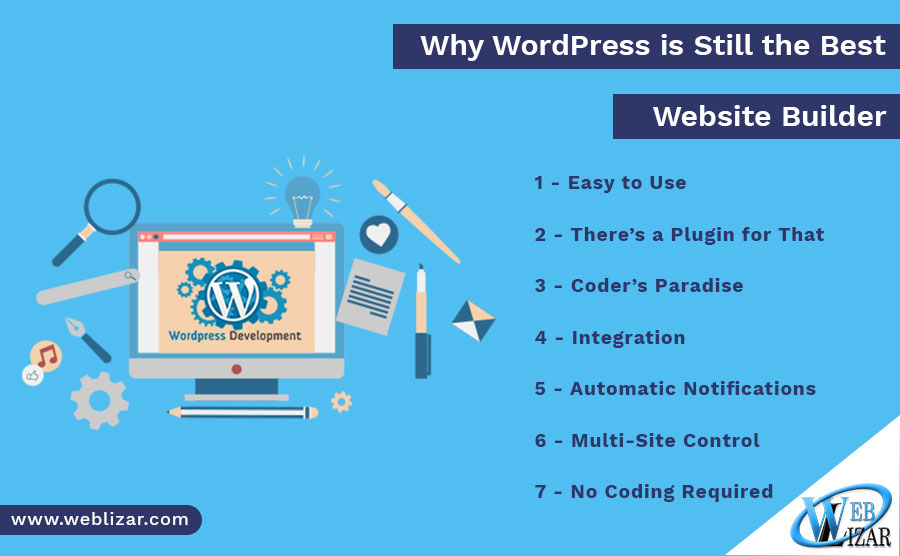Between the easy to use the system and fully customizable potential, there is no other CMS that really comes close to WordPress. That’s why nearly 30% of all websites are built using WordPress. If you are looking for the best way to build your website, the answer has been and continues to be WordPress. At a low cost of free, you’d be crazy to start with anything else.
1 – Easy to Use
When it comes to ease of use, WordPress tops the charts. It’s extremely user-friendly backend experience makes managing a WordPress site simple. A stock WordPress site will set up your functions for your website, and separate the areas where they need to be. Your main pages will go under pages. Your blog posts go under posts. Customizing your theme is under appearance. It’s a simple set up once you learn what each tab does, and it’s potential is limitless when you really know what you are doing.
Compared to builders like Wix and Squarespace, it might be a bit harder to learn, but what you can create with WordPress is far beyond the capabilities of the other two builders. While there is a learning curve, it’s not nearly as steep as a CMS like Joomla. WordPress is the easiest system that gives the end-user full capability of their CMS.
2 – There’s a Plugin for That
Do you want to make your website do something special that no one else has? Well, there is probably a plugin for that. Plugins are a repository of functionality for your WordPress. From contact forms to page builders, there are so many different plugins available on the market for WordPress. Some are free, others have pay for features. You can access plugins directly from the backend of your website too. If you go to Plugins > Add New, you can search through the entire wordpress.org plugin catalog. They will show you the dates of the last upgrades, version compatibility, and ratings right there for you to see and read. When you find what you were looking for, just click install. After a short time, another screen will load with another button that lets you activate the plugin. Once it’s activated, most plugins will add a new option on the left sidebar of the dashboard where you can play with their settings and options.
3 – Coder’s Paradise
WordPress is a free open source platform, so those who know how to code can create anything for their website. With full access to documentation and file locations, coders can create plugins that modify their site with custom functionality. You can even share and sell your plugins to the public.
4 – Integration
Between the plugins and social settings within WordPress itself, you can really turn your website into a hub for all of your internet outreach. You can drive traffic to your website from your social media channels, and you can get those who do land on your website to your other channels through social share settings.
Beyond the simple social share functions, you can use your WordPress as a host to generate leads as well. There are tons of different integrations that third-party apps like MailChimp and WooCommerce. They can provide you the functionality that you would otherwise be unable to produce without custom codes, but the WP engine does it through API codes and calls. It makes creating sales funnels and retargeting campaigns quick and easy.
5 – Automatic Notifications
You WordPress can help you keep your customers in the loop, too. If you aren’t using apps like MailChimp to collect leads and create lists, you might want to look into what WordPress itself has to offer. We’re talking about Jetpack, a lightweight plugin that lets you create lists, blog notifications, manage social buttons, and so much more. It gives you the ability to notify your audience whenever you post, and it will push notifications through your social media channels, too. All you have to do is link your social accounts, and it will automatically make a post or email when you create a new blog post on your site.
6 – Multi-Site Control
For complex companies with tons of different departments and moving parts. You would be interested to know about the multi-site control that WordPress provides your development team. By housing multiple sites under one account, you can seamlessly travel from site to site through a menu on the top left of your dashboard. That makes it simple for developers. And admins to jump from site to site without having to log into another account. This saves so much time when you are working with multiple “properties” under the same roof.
7 – No Coding Required
Really, WordPress doesn’t require coding knowledge. You can make a site with all the bells and whistles by simply looking through the custom themes. Just like plugins, many of these themes are one-click install themes. And they convert the look of your site to whatever style the theme has. You can then customize your new theme in the customization menu in your appearances or the builders that were used to create the themes. There are also pay for themes, and many of them come packed with plugins you would otherwise have to pay to use. All of these pieces and parts will make it so you never have to code. Just click the buttons to make it look how you want it to.
WordPress Puts the Press on Every Other CMS
If you want to build a WordPress site, but it’s going over your head, don’t worry. There are tons of companies that offer amazing managed WordPress services. From web design to custom plugins, you can work with a company to make your WordPress anything you want it to be.

